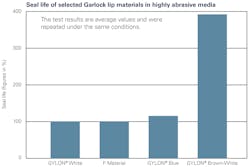Addressing sealing challenges in rotating equipment for the food and pharmaceutical industries
The most challenging operational environments for sealing mixers, agitators and pumps are often found in the food and pharmaceutical industries. When designing, selecting or implementing a dynamic seal into operation in the food and pharma space, it is crucial to consider all the physical challenges the seal may face to ensure sealing success. Further, material certifications, seal geometry and even seal color must also be factored in to allow for maximized seal life, minimized risk and reduced total cost of ownership for both the seal and the rotating equipment.
In this article, we will highlight some of the common environments found within these industries, discuss how the operating conditions affect seal design and selection, and finally, share some common recommendations to maintain a high level of performance in your rotating equipment.
Preventing seal failure
Although the seal is rarely the highest cost item in the mixer and agitator equipment design, seal failure is often the root cause of common equipment shutdowns. The failure of a dynamic seal can lead to loss of control in the manufacturing process, contamination and loss of the media being processed, and failure of the bearings within the rotating equipment. Any of these failure modes can drastically increase the total operating cost of the entire process, far beyond the initial cost of seal replacement.
While the selection of available sealing solutions currently on the market is expansive, the pressing demands of the food and pharmaceutical industries tend to eliminate many potential suppliers, materials and designs. A suitable sealing solution should meet all essential certifications for the food and pharmaceutical sector, so that machine builders and operators of mixing plants and agitators can be sure that their equipment complies with all regulations and requirements. Particularly noteworthy are: EC 1935/2004, FDA and USP Class VI.
Working within the regulatory restraints imposed by the industry being served, it is critical the seal designer, equipment operator, and purchasing agent be aware of at least the following four common challenges: hygienic manufacturing and cleaning; abrasive media; vacuum and dry running operation; and equipment misalignment.
Hygienic manufacturing and cleaning processes
The hygienic production of the various products in the food and beverage industry requires special attention when choosing a sealing solution. In the past, mixing shafts were often sealed with stuffing box packings. This solution is unsuitable from a hygienic point of view. A suitable sealing solution must comply with hygienic design. A component in hygienic design is designed to be cleanable and excludes microbial and particulate contamination of the end product in a hygiene-critical production environment. Hygienic seals must therefore be designed to be free of dead space.
The media in both the production cycle and the cleaning cycle must be safely sealed. The cleaning processes are carried out by means clean-in-place as well as sterilization-in-place. The CIP process is a cleaning method in which individual fully-automated processes run according to strictly specified parameters. The cleaning temperatures are determined according to the application and are usually around 90°C. The CIP process is followed by sterilization using the SIP process. Here, in automated processes, active microorganisms are killed at around 140°C using hot water or steam, depending on the application. The use of chemical disinfectants is also possible during this process.
Sealing solutions must therefore be particularly temperature-resistant, resilient and have excellent chemical media resistance. Failure to account for the CIP/SIP processes can result in seal failures with elusive root causes — as the process media can be found to not be a driving cause of failure, often only after extensive root cause analysis. Not only should material selection be intentional with these concerns, but the geometry and the construction of the seal is critical.
Abrasive media
Abrasive media also present special challenges for sealing solutions in the food and beverage industry. Abrasive media can be crystalline structures such as sugar, as well as powders, grains and many other organic and inorganic starting materials for the end product. These dry ingredient blends require outstanding wear resistance of the seal materials and compounds as they are mixed at high peripheral speeds. It is critical to identify dynamic seal materials designed for abrasive operation while still maintaining all the material certification requirements of the industries being served. Care must be taken to choose seal materials specifically formulated to have excellent abrasion resistance. The performance capability of modern specialty materials has greatly improved on traditional standard material formulations.
Vacuum and dry running operation
In the food, pharmaceutical and cosmetics industries, the starting media are often mixed under high pressure and vacuum. Commonly found in any evaporation, reduction or clarifying processes, all materials in the closed loop process must be able to withstand the combination of temperature, rotation and reversals in pressure direction as the vacuum is applied and removed from the media chambers. Sealing solution materials must therefore be able to withstand high pressures and extreme vacuum processes in addition to all other requirements. Proper seal design will not only prevent vacuum losses and the related loss of process media, but a correctly chosen seal will also reduce the load on vacuum pumps, resulting in an overall reduction in the total cost of ownership. Vacuum and dry running applications will almost always require a PTFE sealing element, and often a redundant seal configuration such as a PS Dual Tandem Seal.
Misalignment
Mixers and agitators are especially challenging to seal as the equipment size — or the load on the equipment shaft — increases due to relative movement between the shaft centerline and the seal location. This relative movement is referred to as misalignment and can range in scale from thousandths of an inch to tenths of inches. As the shaft moves relative to the seal, load is unevenly distributed around the seal contact surface. This can lead to premature wear, even immediate failure to maintain the seal. Common indicators of a seal failure related to misalignment are uneven shaft wear, extrusion of packing materials, and motor over-voltage warnings. Proper seal selection and design drives include seal selection to account for any possible misalignment, as well as strategic seal location to minimize shaft misalignment.
PTFE: Rising to the challenge
This combination of environmental conditions and performance requirements will almost always necessitate a PTFE lip seal. Commonly found are seals with a reversed lip configuration to remove the possibility of internal media entrapment. Reversed Lip and Dual Opposed configurations have exhibited proven performance when sealing the various conditions expected within these applications. This includes when different dry and/or liquid ingredients are mixed under the influence of high temperatures or vacuum, along with cleaning processes with chemical cleaning cycles taking place where the mixing process is repeatedly stopped and started. These combined properties create a uniquely challenging sealing environment, making the seal selection especially critical. However, these PTFE lip seals are a proven solution to consider. Given their consistent performance and reliability, there’s good reason to trust them becoming an indispensable choice to tackle the uniquely challenging sealing environments across the food and pharmaceutical industries for years to come.
Joshua Cavinee is a Senior Application Engineer at Garlock. He graduated from The Ohio State University with his B.S. in Aeronautical and Astronautical Engineering. Joshua’s experience spans 16 years in Fluid Sealing/Handling Engineering, 10 years in Commercial Aerospace, and 5 years in Industrial Fluid Sealing.





